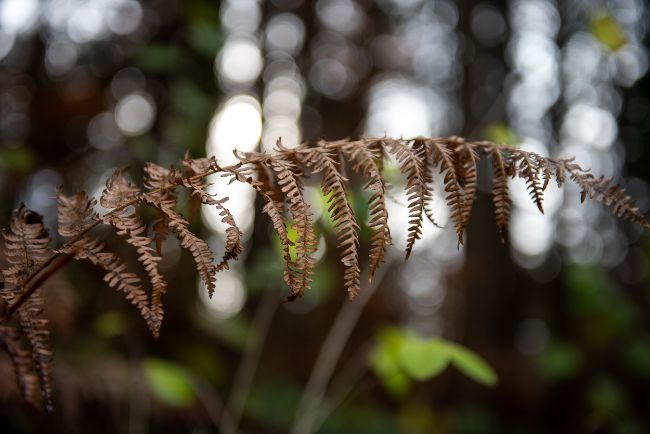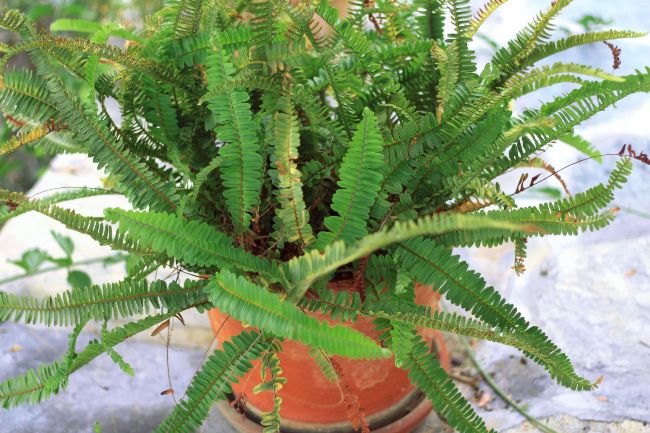Long, graceful fronds on the Boston Fern (Nephrolepis exaltata) give it an elegant appearance, reminiscent of by-gone days. These attractive ferns are very popular houseplants, but it can be challenging to keep them looking their best. This article will explain why Boston Ferns get brown leaves and help you identify the cause and restore your plant to perfect health.
Boston Ferns get brown leaves due to underwatering, low relative humidity, too much sun exposure, and temperatures extremes. Other sources of stress can cause brown leaves, such as overfertilization and transplant shock, as well as normal causes such as acclimation or aging foliage.
Causes Of Brown Leaves On Boston Ferns
Boston ferns (Nephrolepis exaltata) can be a little challenging to keep in perfect condition. They prefer moderate lighting and fertilizing, but are quite particular about their water and humidity requirements.
High humidity and consistently moist soil will greatly help to prevent your Boston Fern from getting brown leaves. Let’s look at each of the common causes of brown leaves on Boston Ferns to see how we can help your plant.
Underwatering
For many types of houseplants, overwatering is the number one cause of problems. With Boston Ferns, though, this is the opposite. The number one reason why Boston Ferns have brown leaves is underwatering. These plants like their root ball moist at all times, without being soggy, to prevent root rot.
Avoid watering your Boston Fern on a schedule, but instead, monitor the condition of the plant and the dampness of the soil to determine when to water your plant next.
Bear in mind that many factors, including the time of year, type and size of the pot, size of the plant, and choice of soil will all impact how often you need to water your Boston Fern.
You can reduce watering in the winter months when houseplants naturally slow their growth or become dormant, but make sure the root ball still stays consistently damp.
How To Give Your Boston Fern The Appropriate Amount Of Water To Prevent Brown Leaves
When the top of the potting soil becomes dry to the touch, water your fern thoroughly until excess water begins to drain out the holes in the bottom of the container. During warm months this might mean watering every few days but be guided by your individual plant.

Low Humidity
Native to tropical climates, including Florida, the West Indies, Mexico, Central and South America, Africa, and Polynesia, ferns thrive in areas where the relative humidity is high.
When the relative humidity is low, you will start to see your Boston Fern getting brown leaves. Unfortunately, many homes have an average relative humidity of no more than 20 to 25%, which drops even lower in the wintertime. This is well below the preferred humidity level of 50% or higher for Boston Ferns.
How To Fix Humidity Problems Causing Brown Leaves On A Boston Fern
To keep your Boston fern from developing brown leaves from low humidity, you can group plants together to naturally raise the humidity, set up a pebble tray or, use a home humidifier close by to increase the moisture in the air.
Bathrooms can be a great location to keep Boston Ferns due to their naturally higher humidity levels. Read this article for more detail on how to increase humidity for your houseplants.
Excess Light
Light is needed for plants to photosynthesize, but not every plant wants to live in full sun conditions, receiving bright, direct light on their leaves all day long.
Boston Ferns need bright, indirect light to produce healthy, green fronds, but excess direct sunlight, even through a window, will result in your Boston Fern leaves turning brown. Sun exposed leaves will typically be affected first by excessive light.
How To Fix Brown Leaves On Boston Ferns Caused By Light Problems
Avoid putting your Boston Fern in a south-facing window since the light is too bright and direct. Instead, choose a window that receives dappled, filtered light.
If a south-facing window is your only available option, move the plant further away from the window to keep it out of the sun’s direct rays. You can also place your plant close to a taller plant so the larger specimen can offer some shade from the sun.
Temperature Problems
Your Boston Fern likes to live in a spot where the temperature is a little bit cooler than many houseplants. Boston Ferns prefer temperatures of between 60-75℉ (16-24℃) and prefer spots on the cooler end of that range, so look for a cool place in your home.
Brown leaves on Boston Ferns can develop if they are exposed to temperatures much outside this range or if they are subject to hot or cold drafts.
How To Fix Temperature Problems Causing Brown Leaves On Your Boston Fern
Avoid drafts from your heating vents or air conditioning and blasts of cold air from leaky windows or doors in winter. Plants can tolerate short chunks of time when temperatures drop down to 50℉ (10℃) but won’t tolerate frequent or prolonged cold exposure.
You may wish to place a digital thermometer near your plant to see if temperature extremes are causing brown leaves on your Boston Fern. You can then adjust the location of your plant depending on the maximum and minimum temperatures recorded.

Overfertilization
Boston Ferns do not need much in terms of fertilization. I normally provide a dilute solution every 2-3 months. If you are fertilizing frequently, or if you can see fertilizer salts accumulating in the soil, then this may well be the cause of brown leaves on your Boston Fern.
Excess fertilizer can cause a number of problems, causing direct toxicity effects as they are absorbed into the plant, but also directly damaging the roots, preventing them from performing their normal functions. All this results in brown leaves on your Boston Fern.
How To Fix Fertilizing Problems
Only fertilize your plant a couple of times a year, using a water-soluble fertilizer, following the label directions correctly. If you are using a general fertilizer for all plants, dilute it to half the recommended strength. Potted plants typically need much less fertilizer than outdoor plants, so extra caution is required.
Make sure to apply the fertilizer directly to the soil, avoiding getting any on the foliage, which can cause direct leaf damage. If you see salt deposits starting to accumulate on the soil surface, you should flush the soil thoroughly. Let the water run through the pot for about 5 minutes to help the excess salts dissolve and get rinsed out of the soil.
Read more about fertilizing houseplants here. I cover all the different types available and how to use them to keep your houseplants thriving.
Becoming Rootbound
As your Boston Fern grows, it will develop an extensive root system that will quickly fill the potting soil in the container. When left to grow in the same container over an extended time the roots become tangled, creating a dense clump of roots.
When roots become root-bound, they cannot access enough water and nutrients to meet the plant’s needs, which can result in brown leaves on your Boston Fern.
How To Fix Rootbound Boston Ferns
Monitor your Boston Fern for signs of becoming rootbound, which include seeing excessive root growth through the drainage holes, faltering growth, or having soil that dries out rapidly after watering. Repot into a new container that is 1 to 2-inches (2.5 to 5 centimeters) larger in diameter to give the roots more room to grow and spread out.
Transplant Shock
Moving your plant to a new container, or propagating new plants through division can cause your Boston Fern to develop brown leaves due to transplant shock. This occurs when the root system of a plant is damaged or harmed during the process; in severe cases, transplant shock kills the entire plant.
How To Prevent Or Fix Transplant Shock
To minimize transplant shock, repot or divide plants in early spring or late fall, avoiding the middle of summer when plants are growing at their highest rate. Try to minimize disturbing the root ball, keeping as many of the small roots intact as possible, and avoid shaking the soil out of the root ball.
If your plant does experience transplant shock, give it time to heal itself, keeping the root system moist and trimming up to one-third of the plant’s foliage to allow your Boston fern to focus on regrowing roots.
Acclimation
Sometimes its necessary to move plants to a new location, such as when you bring your Boston Fern home from the store, or if you change its position in your home. Alternatively, you may want to move your Boston Fern outside for a while in the summer when the weather is nice and bring it back inside before fall rolls around.
This change in conditions can result in your plant experiencing stress, even if you try to acclimate it slowly, causing your Boston Fern to develop brown leaves.
How To Fix Brown Leaves Caused By Acclimation Problems
Acclimation problems are difficult to avoid entirely, but they can be minimized. During the transition, make sure to keep the root ball moist, never letting it dry out. If possible, make a move to a new location slowly, place the plant in its new home for a couple of hours at a time, increase the length over a week or two, and give it time to adjust slowly.
Natural Aging

As your Boston Fern grows and matures, it is natural for older leaves to turn brown and fall off. New growth is prioritized by the plant, and lower, older foliage dies off.
How To Fix Brown Leaves Caused By Aging
Unlike the other causes of brown leaves on Boston Ferns, there isn’t any way to fix this or prevent it from happening since it is natural. Simply prune off any dead foliage to keep your plant looking its best.
Removing Brown Leaves From Boston Ferns
The disheartening part about brown leaves on your indoor plants is that once the problem occurs, you can’t repair that brown, dead leaf tissue. The only solution is to remove the unsightly leaves.
Start by finding a pair of sharp scissors to minimize damage to healthy plant cells in the leaves, reducing the energy the plant must expend to heal the open wound. Wipe them down with rubbing alcohol to reduce the risk of transmitting diseases from plant to plant. Use your scissors to cut the leaf all the way back to the main stem of your fern.

